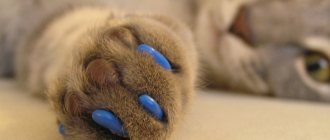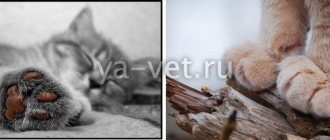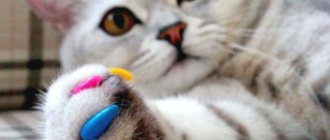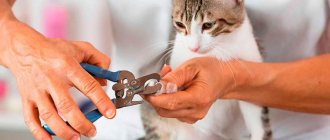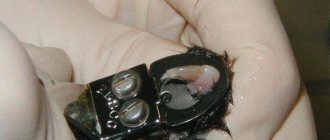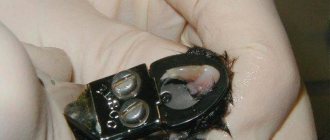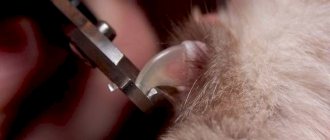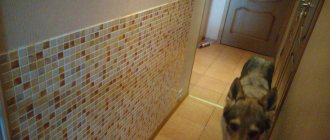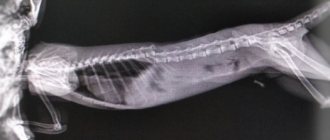Price for “soft paws” surgery for cats at the vet:
| Service | Price, rub |
| Onchyectomy (“soft paws”) on 2 paws | 6000 |
| Onchyectomy (“soft paws”) 1 claw | 700 |
| Anesthesia for a cat during onchyectomy | from 500 |
“ Soft paws for cats , there are scratches on the paws...” In the daily life of their pets, owners of domestic cats are faced with many acute problems that have to be solved one way or another. The fluffy purr needs not only to be fed and treated, but also raised, accustomed to life in an apartment and in a family. Some skills are acquired without problems, while others remain a subject for constant battles. For many owners, the real test was the sharp claws of their pets. Which they grind off on everything, or when playing, leave painful scratches on children and adults. New furniture, new wallpaper can become a new victim for growing claws. And any animal, even the most peace-loving one, is not immune from attacks of aggression or the desire to dig its claws deeper while playing with you or a child.
What to do? Often people are faced with a choice: give the animal away, let it go outside, even euthanize it, or undergo surgery - soft paws for cats. Before you run to the veterinary clinic so that your kitten’s paws become like soft pillows, explain to yourself all the nuances of this surgical intervention, its consequences for cats and the peculiarities of life for pets after surgery.
What is Soft Paws for Cats surgery?
When all the means to re-educate a cat have been tried and the question arises, the owner of the animal thinks about where the declawing procedure can be done and what its consequences .
Let's start with the fact that any surgical intervention carries with it
certain risk:
- Some animals have difficulty recovering from anesthesia
- After the operation, any complications may develop.
Onchyectomy ( claw amputation ) is the removal of the ungual, distal phalanx . There is a second version of this operation, when the tendon of the flexor muscle of the finger is removed , and because of this the claw remains in its bed, the cat cannot “release” the claws.
During this operation, only the claw phalanx is removed. When the limited access method is used, self-absorbing sutures are applied, this allows the wounds to heal quickly, and the animal, especially the kitten, quickly adapts and lives a normal active life.
Indications for surgery soft paws for cats
The soft paw operation has relative indications for use, since no one can call this intervention necessary for health reasons. But still, the aggressive behavior of the animal and the ineffectiveness of using alternative means forces the owner to resort to this last resort. Cases are described when an animal, in a fit of anger, or playfully, scratched the face of a child, and attacked the owner at night. Ordinary scratches in weakened people, the elderly and children can cause a complication - felinosis . This infectious disease, caused by bacteria of the genus Bartonella, is characterized by fever, swollen lymph nodes, and in severe cases, conjunctivitis, damage to the nervous system, enlarged liver and spleen, and blood poisoning. Every cat scratch must be disinfected !
Contraindication to amputation of claws in cats
A contraindication to amputation of claws in cats is the cat’s free stay at home and on the street, since it is deprived of the opportunity to stand up for itself in the event of an attack, climb a tree, catch its claws when falling, etc. By deciding on this operation, you take responsibility for life and safety defenseless creature.
Although it should be recognized that owners who have become attached to their pets already feel their duty to them and strive to make their life as comfortable as possible with their family.
Declawing of cats and cats
Surgical declawing of cats and cats (onychectomy, in other words, soft paw operation), as usual, does not have any therapeutic meaning, but more often it is still performed in order to protect the furniture in the house, carpets, wallpaper, as well as the owners themselves (especially small children) from scratches from cat claws. Less commonly, the procedure is performed for surgical or social reasons (crooked growth of claws from birth, irreparable structural distortions of the nail tissue, epilepsy , etc.)
Having decided to perform an onychectomy, the pet owner needs to be aware that after declawing, the cat will only be able to live indoors (all independent walks on the street must be excluded). Cats deprived of claws will be unable to defend themselves, escape from threats, climb a tree, or get food for themselves by catching a mouse or a bird.
Moreover, a high incidence of injuries in cats without claws can also begin when kept indoors. We know of several episodes of high-altitude injuries (falls from heights), when a cat deprived of claws simply slipped off the iron window reflections, unsuccessfully trying to catch on. The intention of declawing must be carefully considered.
Relevant! If your pet goes outside, then you definitely can’t perform soft paw surgery, because this will harm the natural self-defense functions in the surrounding area of living.
The Neotlozhka veterinary clinic traditionally performs this operation only on the front legs. After the operation, it is necessary for the animal to stay in a carrying cage for 2-3 days, and use pieces of paper instead of cat litter in the tray. Within two to three weeks after onychectomy, adaptation to other living rules begins; when the cat jumps, injuries are possible, because such a cat does not always have the ability to stay in place when landing.
• declawing of cats occurs under general anesthesia.
• the duration of the operation is 40-60 minutes.
• The postoperative stage involves bandage dressings , as well as wearing a collar to protect the bandaged paws.
Despite its apparent ease, the surgical procedure for declawing cats is performed by very few veterinarians . And the free space, as far as we know, is filled with absurd statements or fictitious conjectures. Quite recently, everyone was discussing the removal of paranal glands in ferrets . Some veterinarians (and also non-veterinary specialists) only talked about how much deterioration such an intervention brings. Simply, practically no one performed this operation (without error!). There was not much practice in this area. However, those who tried to operate at random received postoperative complications. This is how an understanding was formed. And later they published translated foreign specialized literature, as well as international master classes. And veterinarians gradually mastered this operation. Therefore, speculation and prejudice disappeared by themselves. Currently, almost no one discusses this topic.
The same thing, we assume, will happen in the future with the concept of declawing cats. Simply, veterinarians will learn to perform this surgical procedure, so all misunderstandings will subside on their own.
Once at an international forum, our colleagues invited anyone to follow 3 cats, one of which had its claws removed. And find out, without holding it in your hands, which of them appears with the claws removed.
More than 50 people were unable to accurately determine by gait or behavior where the “clawless” cat was. We rightfully assert that a surgical operation to remove claws from cats does not in any way lead to injury to your pet!
We do not force you to undergo surgery in cases where it is possible to resolve the issue without it. However, our veterinarians have been performing such interventions for 7 years. Because we can carry out this operation professionally and have never noticed the deterioration that they talk about in RuNet.
Feedback about the operation from animal owners
Svetlana:
The soft paws did not immediately dare to undergo the operation, because they did not want to injure their cat, but it was no longer possible to put up with her pranks every time when we had guests. It was also impossible to lock him in the next room, because the cat began to scream loudly. The cat was so jealous of my husband and me that it even attacked the guests.
The operation went well, but only after it is it necessary to limit the cat’s excessive energy, and also not allow her to jump, so that the stitches on the phalanges do not come apart. During the postoperative period, the animal limped, but then the pain disappeared.
Julia:
The reason why I finally dared to de-claw the cat was not even the daily “parkour” throughout the apartment, the torn wallpaper, and the mutilated leather sofa (by the way, very expensive!), but the fact that the cat began to scratch the guests on the person, so I decided to consult a veterinarian and surgeon.
Ksenia:
Every year, our cat’s temperament changed significantly for the worse, and with the appearance of another animal in our house - a toy terrier, quarrels began to occur repeatedly among them, and Murka started them. Once it even got to the point where she almost gouged out the dog’s eye. The veterinarian advised two ways out of this situation - either replace the anti-scratch pads every 2-3 months (they are glued on top of the claws), or have soft paw surgery.
Right now I'm still thinking.
How is the operation soft paws for cats performed?
If you have made a conscious decision to have a soft paw surgical procedure, it is important to find a good veterinarian who will competently and skillfully perform this operation. It is usually performed under general anesthesia. No one “rips out” the claws, the doctor carefully removes them using special tools, the pillows are not injured, sutures are placed on the incisions, it is better if they are absorbable. The paws are bandaged to protect them from bleeding. Additional medications may be prescribed to help the cat recover better from anesthesia.
Post-operative cat care
Usually after 6-10 hours
The cat can already move independently.
It is recommended to keep an eye
on her for at least
a day or two until she completely recovers from anesthesia; this time is individual for each animal.
Veterinarians recommend providing the animal with a comfortable bed on the floor, limiting walking and jumping in the first hours after surgery, and not allowing jumping from a height. Day or two after surgery
The paws may bleed and the cat will feel uncomfortable stepping on them, but within 10-12 days everything should return to normal and the cat will continue to run, play and jump on cabinets.
Surgery and aftercare
Declaw removal can be done both in the clinic and at home. The procedure is not technically difficult, so it does not require special preparation (except for fasting for several hours).
Before the operation, the surgeon conducts a full clinical examination of the patient; if no signs of disease are detected, he prepares him for the manipulation itself.
The animal is given premedication (for a smooth introduction to anesthesia), then a drug that ensures a complete shutdown of consciousness, so during declawing, the cat does not feel anything. A small incision is made on each toe of the front paws, through which the claw and phalanx containing the claw bed are removed.
Several skin sutures are placed on the wound, after which it is treated with an antibacterial agent. The surgeon must remain with the patient until the animal begins to recover from anesthesia.
After a few hours, the cat finally comes to her senses and leads a normal life. To prevent the development of infection, increased hygiene measures should be taken (keep the animal's floor and tray clean).
It is also necessary to strictly follow the doctor’s recommendations; only in this case can the veterinarian guarantee the absence of complications. During the first 5-7 days there is slight lameness, causing the pet some discomfort, which does not require human intervention and goes away on its own.
Possible complications after surgery soft paws for cats
On the Internet you can find a lot of “horror stories” about onchyectomy. The opinion is expressed that the animal becomes disabled with a broken psyche, its character changes for the worse. Cats move worse, the harmony of the musculoskeletal system is disrupted. But a cat's claws are not used when walking and supporting themselves.
, since it rests on the first and second phalanges of the fingers, and the last claw phalanx remains retracted.
Claws are needed only for hunting and protection from enemies .
Complications after this operation , a description of which can be found on the Internet, occur as a result of poor quality performance: a fragment of the distal phalanx is left, non-absorbable threads are used for sutures, and aseptic conditions are violated.
Myths and truth about the consequences after surgery: soft paws for cats
There are also cases described when a cat becomes cowardly, aggressive, and unkind due to the “soft paws” procedure. Most people who agree to this operation for their pets do not notice such negative changes in the cat’s character; its gait, coordination and behavior do not change.
Soft paws for cats - conclusion
Of course, it is up to you to decide whether your pet needs to be declawed. Often, owners try more gentle methods of exposure - repellent sprays, various scratching posts, claw trimming, silicone pads. And only after making sure of their low effectiveness do they resort to this procedure. After weighing all the pros and cons, do not blame yourself if the cat puts out its claws in places and places out of place, but seek qualified veterinary help. Not all veterinary clinics perform this operation, but if it is included in the list of services, ask how it will be performed, what materials will be used, whether the veterinarian supervises the patient’s recovery from anesthesia and other questions that interest you.
At the veterinary clinic, our surgeons will be happy to talk to you and answer all your “painful questions.” A consultation with a doctor by phone is free of charge; also, if it is impossible to deliver the cat to the clinic (and they may be very aggressive or simply scared), simply fill out a request for a veterinarian to come to your home. You can find out about all services and prices for them by calling our phone. Remember that only you are responsible for the life and health of your furry household, as well as for the safety and peace of mind of other members of your family!
